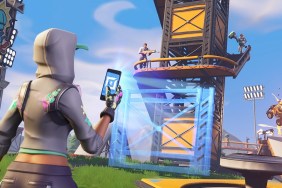Merrily, merrily, merrily…
Dreams had a slightly underwhelming presence at Playstation Experience. It's unavailable to the general public, for one; it's in a small corner, in the back of the Media Lounge (available only to invited press) where it was casually demoed by two of its developers—one of them Technical Director Alex Evans who spoke with me about the game—who were quietly and meticulously building game worlds in the same way that Bob Ross painted landscapes on public access television.
That's not a joke. Dreams' creative design team comes from a painting tradition, and the whole design is built around the Impressionist art era, where the textures have a naturally scratchy look reminiscent of paint strokes (though this effect can be scaled back to look more solid). Their goal is to have people building game concepts that would normally take months in a single day by keeping them sketchy and gestural, iterating quickly, as Ross did whenever he decided to put a "happy little tree" on his canvas
.
The menu selection is done using a palette structure that allows you to select brushes, environments, lights, and characters, then place them in the environment with a stamp, before adding and augmenting them. In practice, the developers moved between using two Playstation Move controllers, or a Dualshock 4, which they said had different advantages for environment creation. Using either method, they could create a small completed play environment over the course of a half-hour.
The ease with which I saw the artists create a world from scratch can't be overstated. In one forest environment, he painted three scratchy swaths of green in the air, then turned these into a stamp that he could move and twist in 3D space to create the green of the fir trees. After grabbing some rocks and modifying them, he placed a glowing square inside of them, creating a door to the next area (or "dream"). Just as simply he placed several lights in the environment, in addition to the sun—which can be moved around—and the painted skybox, where you can change the colors which changes the reflected light in the environment; so if you wanted to visually change the time of day in the same place, you could simply replace the skybox with different colors and move the sun to have a completely different visual look.
Dreams isn't limited to just creating environments. It has an in-depth character creator, where the bodies can be heavily modified to an astounding degree. Rather than primarily using traditional animation techniques, Dreams uses gameplay performance as a way of creating narratives. So if you want an NPC to do something scripted in the scene, or in reaction to something the player does, you can use the game's "record" feature, then manipulate your NPCs like a puppet, to get them to perform the actions that you want, creating a more dynamic way of getting character performances. There are also systems for integrating voice acting and music to give players and creators the ability to complete their sketches as quickly and fully as possible.
Similarly, if you want something physical to happen in the environment, you can puppet that as well. Since the game uses a physics engine, you can also create a puppeted effect that then becomes an in-game one, if you free elements in the environment from constraints after the player does something. For instance, you can step in a particular area or do a particular action, then use this to trigger a tree falling or an avalanche, etc. This makes the game creation tool a perfect choice for budding game creators looking to get a handle on how development works without having to dive into code.
Since Dreams is heavily community-driven, everything that a person creates and uploads gets their private stamp on it. So if you download some templates and use them for your game, narrative, or film, the assets you used and the people who made them will be listed in the credits. This doesn't just apply to art assets, but also to the game logic where interactive processes can also be saved and shared. Physical assets can be exported to other engines, and the developers want to see assets from dreams used in game engines like Unity, Unreal, and animation programs like Maya; traditional media spaces for creating games and animated films.
While we didn't get into it, one of the developers told me that due to the gestural style, material cost was very low for the assets, with them being measured in kilobytes, and that developers in the game shouldn't think in traditional terms of polycounts. The game, though, will have a system like LittleBigPlanet's thermometer for how much memory is in use. The game itself without any of the assets is also incredibly small, only around 100MB, meaning that the size of game experiences will be in what people do with them. When you run out of space, you can build a bridge or door to the next dream that will progressively build the next level as you move through it.
Making games is an iterative process. Designers build worlds, and then rebuild and refine, until the games eventually come together as whole pieces. But it takes a huge coordinated effort, especially the larger the game budgets and the larger the ideas. Dreams aims to make it all more accessible, but more importantly fun to build and to watch. Game creation, even in games that have level-building options, has always felt like a chore for many people. But in Dreams it looks, and aims to be, like sketching out an idea by hand, giving the power to create interactive environments to everyone. It is, by far, the coolest thing I've seen in games all year. Dreams has no release date at this point but will be PS4-exclusive.










